Table of Contents
Living in a small space doesn’t mean you have to sacrifice style or functionality. With smart interior design, you can make your compact living area feel spacious, comfortable, and inviting. Whether you’re in a studio apartment, a tiny house, or simply a cozy room in a larger home, there are plenty of ways to maximize your space without compromising on comfort or aesthetics. Let’s dive into some practical tips and strategies that will help you get the most out of your small space.
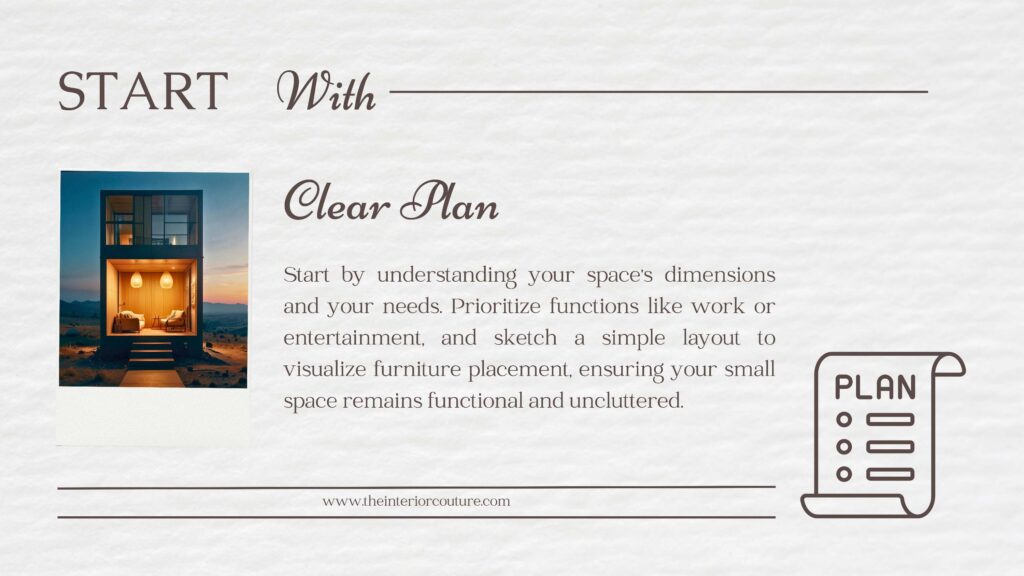
1. Start with a Clear Plan
When it comes to interior design, especially in small spaces, planning is crucial. Before you start buying furniture or knocking down walls, take some time to assess your space and determine your needs.
Understand Your Space:
The first step in smart interior design is understanding the dimensions and limitations of your space. Measure your room’s length, width, and height, and note the location of doors, windows, and other architectural features. Knowing these details will help you make informed decisions when selecting furniture and arranging your layout.
Identify Your Needs:
Next, consider how you plan to use the space. Do you need a place to work, sleep, entertain, or all of the above? Prioritize your needs and focus on creating a layout that meets them. For example, if you work from home, you’ll need to carve out a dedicated workspace. If you love hosting friends, a functional seating arrangement should be a priority.
Sketch a Layout:
Once you have a clear understanding of your space and needs, sketch out a rough layout. This doesn’t have to be a professional blueprint—just a simple drawing that helps you visualize where things will go. This step will prevent you from overcrowding the space and ensure that every piece of furniture has a purpose.
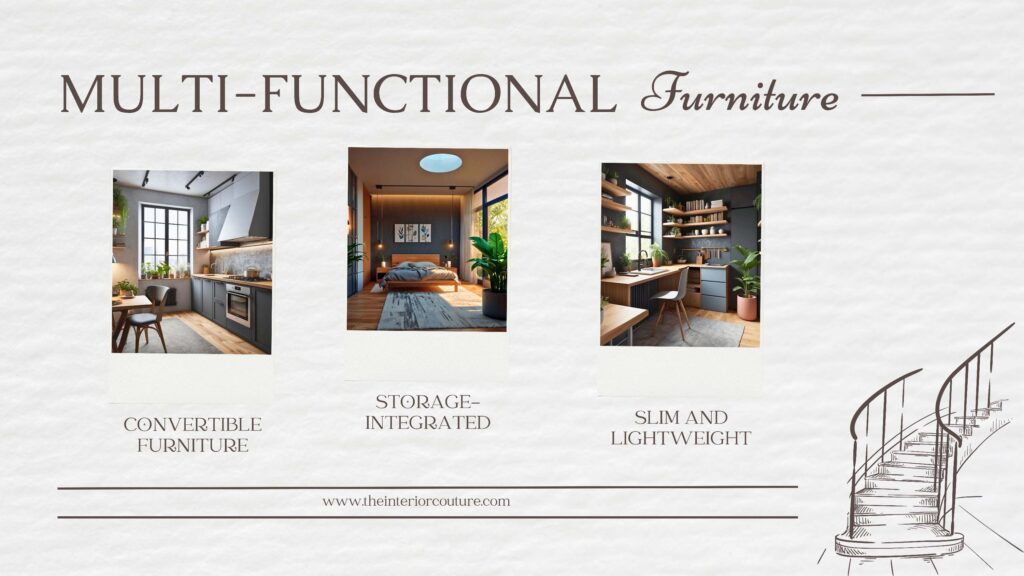
2. Choose Multi-Functional Furniture
In small spaces, every piece of furniture should serve more than one purpose. This is where smart interior design really shines, as it allows you to maximize functionality without sacrificing style.
Invest in Convertible Furniture:
Convertible furniture, such as sofa beds, fold-out desks, or extendable dining tables, are game-changers for small spaces. These pieces can transform based on your needs, giving you the flexibility to switch between different functions throughout the day. For example, a sofa bed can be a cozy spot for lounging during the day and then convert into a guest bed at night.
Use Storage-Integrated Pieces:
Furniture with built-in storage is another smart choice for small spaces. Think of ottomans with hidden compartments, bed frames with drawers underneath, or coffee tables with shelves. These pieces help you keep your space clutter-free while also providing the storage you need for your belongings.
Opt for Slim and Lightweight Designs:
Bulky furniture can make a small space feel even smaller. Instead, choose furniture with slim profiles and lightweight designs. Pieces with exposed legs or open frames, for example, create a sense of openness and allow light to flow freely around the room.
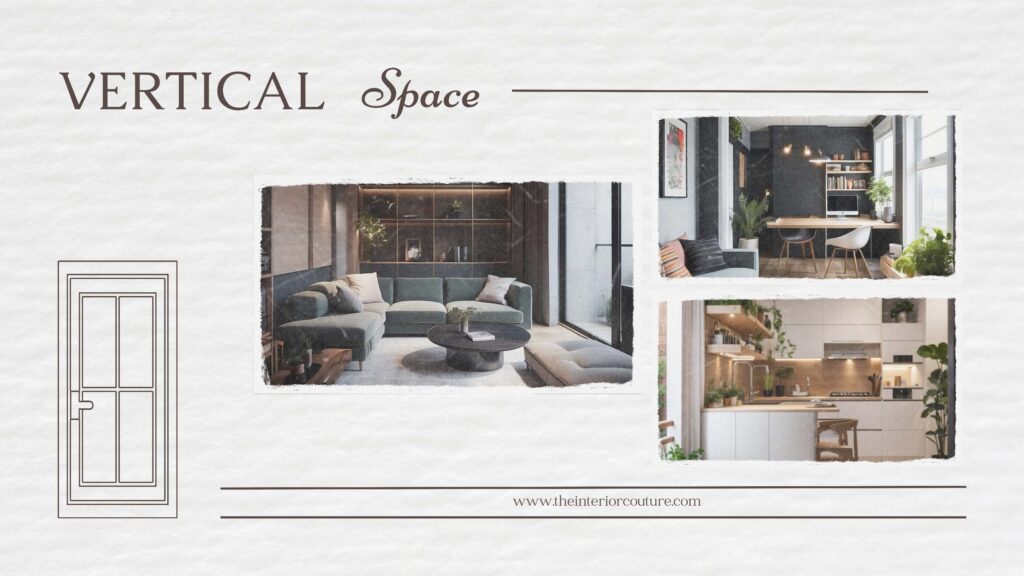
3. Maximize Vertical Space
When floor space is limited, it’s time to think vertically. Utilizing the height of your room is a key aspect of smart interior design, especially in small spaces.
Install Tall Shelving Units:
Tall bookshelves or shelving units are perfect for small spaces because they provide ample storage without taking up too much floor space. Use these shelves to store books, decorative items, or even kitchen supplies. To keep things visually appealing, mix closed cabinets with open shelving to balance storage and display.
Hang Items on Walls:
Take advantage of your walls by hanging items like mirrors, artwork, or even functional pieces like hooks and racks. Wall-mounted hooks are great for storing bags, coats, or hats, while a pegboard can keep kitchen utensils or office supplies organized and within reach. Mirrors are particularly useful because they reflect light and make the space feel larger.
Consider Lofted Furniture:
If your ceiling height allows, consider lofting your bed or desk to create more usable space below. A lofted bed, for example, can free up floor space for a desk, seating area, or additional storage. Just make sure you have enough clearance to move comfortably in the lofted area.
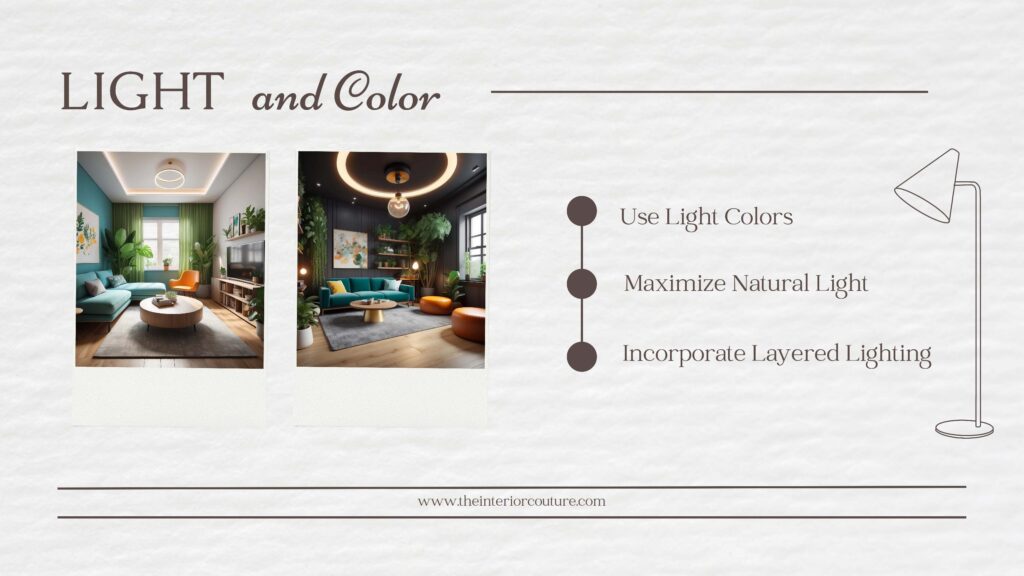
4. Embrace Light and Color
Lighting and color play a significant role in how spacious a room feels. By making thoughtful choices in these areas, you can enhance the perception of space in your small living area.
Use Light Colors:
Light colors, such as whites, pastels, and soft neutrals, can make a room feel larger and more open. Dark colors, on the other hand, tend to absorb light and make a space feel more enclosed. If you love bold colors, consider using them as accents rather than on large surfaces like walls.
Maximize Natural Light:
Natural light is one of the best ways to make a small space feel bigger. Keep window treatments minimal—think sheer curtains or blinds that can be fully opened to let in as much light as possible. Mirrors, as mentioned earlier, can also help amplify natural light by reflecting it around the room.
Incorporate Layered Lighting:
In addition to natural light, layered lighting is essential for creating depth and dimension in a small space. Use a combination of overhead lighting, task lighting, and ambient lighting to brighten the room and highlight different areas. For example, place a floor lamp in a dark corner, use under-cabinet lighting in the kitchen, and add table lamps for a cozy, warm glow.

5. Keep it Clutter-Free
Clutter is the enemy of small spaces. To maintain a smart interior design, it’s crucial to keep your living area tidy and organized.
Adopt Minimalism:
Minimalism and small spaces go hand in hand. Adopting a minimalist approach to interior design means focusing on quality over quantity. Keep only the items that you truly need or that bring you joy. This not only makes your space feel larger but also creates a more serene and stress-free environment.
Use Clever Storage Solutions:
Smart storage solutions are essential in small spaces. Look for creative ways to store your belongings, such as using baskets, bins, and trays to corral small items, or utilizing the space under furniture for storage. Consider furniture pieces that can serve dual purposes, like a coffee table that doubles as storage or a bed with drawers underneath.
Regularly Declutter:
Make it a habit to regularly declutter your space. Go through your belongings every few months and get rid of anything you no longer need or use. This will help you stay organized and prevent your space from becoming overwhelmed with stuff.
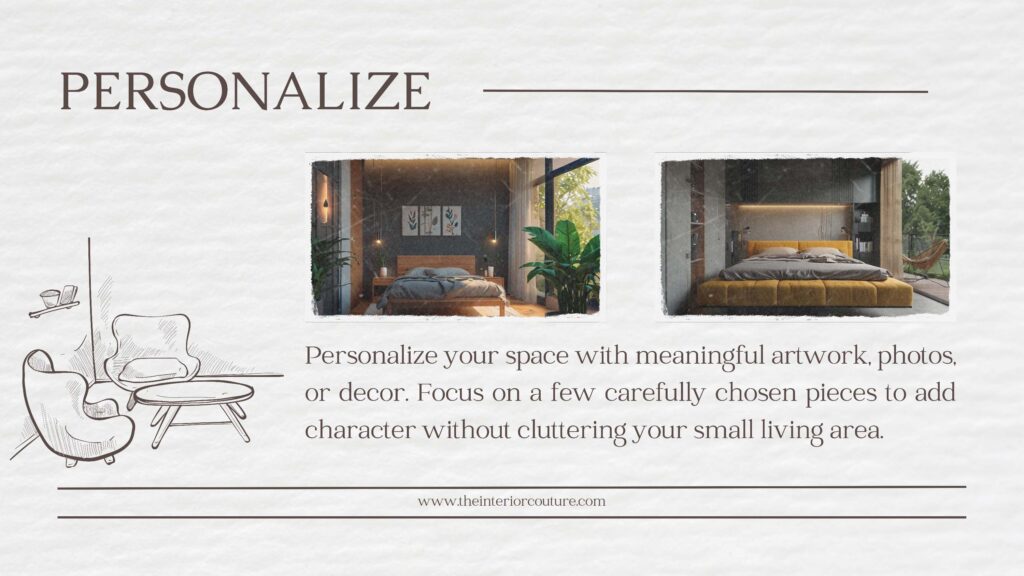
6. Personalize Your Space
Just because you’re working with a small space doesn’t mean it can’t reflect your personal style. In fact, personalization is a key aspect of smart interior design.
Add Personal Touches:
Incorporate personal touches that make the space feel uniquely yours. This could be through artwork, photos, or decorative items that hold special meaning to you. Just be mindful of not overloading the space with too many items—stick to a few well-chosen pieces that add character without cluttering the room.
Create Focal Points:
Creating a focal point in a small room can draw attention away from the size and towards something interesting. This could be a bold piece of art, a statement light fixture, or an accent wall. By focusing on one area, you can add personality without overwhelming the space.
Play with Textures and Patterns:
Incorporating different textures and patterns can add depth and interest to a small space. Mix and match textiles like throw pillows, rugs, and curtains to create a layered look. Just be sure to keep the color palette cohesive to avoid visual clutter.

Conclusion
Maximizing small spaces with smart interior design is all about making thoughtful choices and getting creative with your layout and furniture. By planning carefully, choosing multi-functional furniture, utilizing vertical space, embracing light and color, keeping your space clutter-free, and adding personal touches, you can transform even the tiniest of spaces into a functional and stylish retreat. Remember, it’s not about the size of your space, but how you use it. So, get inspired, start planning, and make your small space work for you!






4 thoughts on “How to Maximize Small Spaces with Smart Interior Design”